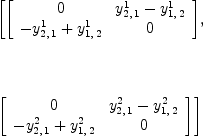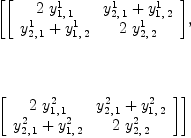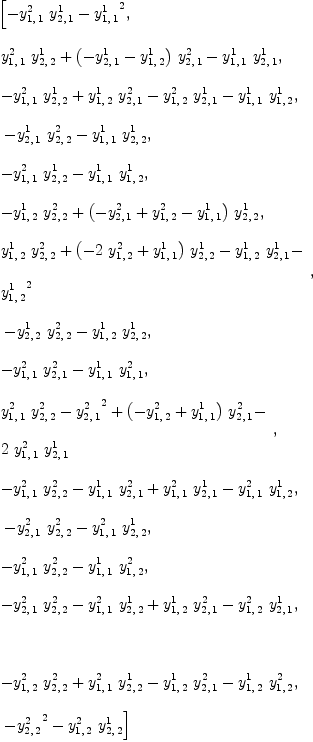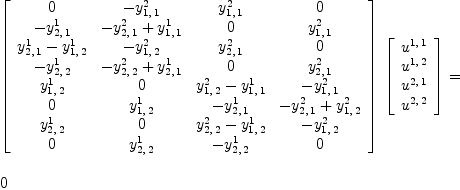|
|
|
last edited 14 years ago by Bill Page |
Edit detail for SandBoxFrobeniusAlgebra revision 21 of 26
| 1 2 3 4 5 6 7 8 9 10 11 12 13 14 15 16 17 18 19 20 21 22 23 24 25 26 | ||
|
Editor: Bill Page
Time: 2011/02/16 17:21:57 GMT-8 |
||
| Note: Y-forms: snails | ||
added:
Y-forms
Left snail and right snail::
LS RS
Y A A Y
Y ) ( Y
U U
i j j i
\/ 0 0 \/
\ / \ / \ /
e f \ / f e
\/ \ / \/
\ / \ /
\ / \ /
\ / \ /
0 0
\begin{equation}
LS = \{ {y^e}_{ij} {y^f}_{ef} \} \
LS = \{ {y^f}_{fe} {y^e}_{ji} \}
\end{equation}
\begin{axiom}
LS=contract(Y*Y,1,2)
RS=reindex(contract(reindex(Y,[1,3,2])*reindex(Y,[1,3,2]),1,2),[2,1])
test(LS=RS)
\end{axiom}
References
- Frobenius algebras and 2D topological quantum field theories
by Joachim Kock
Especially "Tensor calculus (linear algebra in coordinates)" in section 2.3.31, page 123.
See also:
- http://ncatlab.org/nlab/show/Frobenius+algebra by John Baez, et al.
- Ideals, Varieties, and Algorithms by David A. Cox, et al.
An n-dimensional algebra is represented by a (2,1)-tensor
![]() viewed as an operator with two inputs
viewed as an operator with two inputs ![]() and one
output
and one
output ![]() . For example in 2 dimensions
. For example in 2 dimensions
n:=2
| (1) |
T:=CartesianTensor(1,n, FRAC POLY INT)
| (2) |
Y:T := unravel(concat concat [[[script(y,[[i, j], [k]]) for i in 1..n] for j in 1..n] for k in 1..n] )
 | (3) |
Given two vectors ![]() and
and ![]()
P:T := unravel([script(p,[[], [i]]) for i in 1..n])
| (4) |
Q:T := unravel([script(q,[[], [i]]) for i in 1..n])
| (5) |
the tensor ![]() operates on their tensor product to
yield a vector
operates on their tensor product to
yield a vector ![]()
R:=contract(contract(Y,3, product(P, Q), 1), 2, 3)
![\label{eq6}\begin{array}{@{}l}
\displaystyle
\left[{{{p^{2}}\ {q^{2}}\ {y_{2, \: 2}^{1}}}+{{p^{2}}\ {q^{1}}\ {y_{2, \: 1}^{1}}}+{{p^{1}}\ {q^{2}}\ {y_{1, \: 2}^{1}}}+{{p^{1}}\ {q^{1}}\ {y_{1, \: 1}^{1}}}}, \: \right.
\
\
\displaystyle
\left.{{{p^{2}}\ {q^{2}}\ {y_{2, \: 2}^{2}}}+{{p^{2}}\ {q^{1}}\ {y_{2, \: 1}^{2}}}+{{p^{1}}\ {q^{2}}\ {y_{1, \: 2}^{2}}}+{{p^{1}}\ {q^{1}}\ {y_{1, \: 1}^{2}}}}\right]
\label{eq6}\begin{array}{@{}l}
\displaystyle
\left[{{{p^{2}}\ {q^{2}}\ {y_{2, \: 2}^{1}}}+{{p^{2}}\ {q^{1}}\ {y_{2, \: 1}^{1}}}+{{p^{1}}\ {q^{2}}\ {y_{1, \: 2}^{1}}}+{{p^{1}}\ {q^{1}}\ {y_{1, \: 1}^{1}}}}, \: \right.
\
\
\displaystyle
\left.{{{p^{2}}\ {q^{2}}\ {y_{2, \: 2}^{2}}}+{{p^{2}}\ {q^{1}}\ {y_{2, \: 1}^{2}}}+{{p^{1}}\ {q^{2}}\ {y_{1, \: 2}^{2}}}+{{p^{1}}\ {q^{1}}\ {y_{1, \: 1}^{2}}}}\right]](images/8734404072350308678-16.0px.png) | (6) |
Pictorially:
P Q
Y
R
or more explicitly
Pi Qj
\/
\
Rk
In Axiom we may use the more convenient tensor inner
product denoted by * that combines tensor product with
a contraction on the last index of the first tensor and
the first index of the second tensor.
R:=(Y*P)*Q
![\label{eq7}\begin{array}{@{}l}
\displaystyle
\left[{{{p^{2}}\ {q^{2}}\ {y_{2, \: 2}^{1}}}+{{p^{2}}\ {q^{1}}\ {y_{2, \: 1}^{1}}}+{{p^{1}}\ {q^{2}}\ {y_{1, \: 2}^{1}}}+{{p^{1}}\ {q^{1}}\ {y_{1, \: 1}^{1}}}}, \: \right.
\
\
\displaystyle
\left.{{{p^{2}}\ {q^{2}}\ {y_{2, \: 2}^{2}}}+{{p^{2}}\ {q^{1}}\ {y_{2, \: 1}^{2}}}+{{p^{1}}\ {q^{2}}\ {y_{1, \: 2}^{2}}}+{{p^{1}}\ {q^{1}}\ {y_{1, \: 1}^{2}}}}\right]
\label{eq7}\begin{array}{@{}l}
\displaystyle
\left[{{{p^{2}}\ {q^{2}}\ {y_{2, \: 2}^{1}}}+{{p^{2}}\ {q^{1}}\ {y_{2, \: 1}^{1}}}+{{p^{1}}\ {q^{2}}\ {y_{1, \: 2}^{1}}}+{{p^{1}}\ {q^{1}}\ {y_{1, \: 1}^{1}}}}, \: \right.
\
\
\displaystyle
\left.{{{p^{2}}\ {q^{2}}\ {y_{2, \: 2}^{2}}}+{{p^{2}}\ {q^{1}}\ {y_{2, \: 1}^{2}}}+{{p^{1}}\ {q^{2}}\ {y_{1, \: 2}^{2}}}+{{p^{1}}\ {q^{1}}\ {y_{1, \: 1}^{2}}}}\right]](images/5969066627286587503-16.0px.png) | (7) |
An algebra is said to be associative if:
Y = Y Y Y
Note: the right hand side of the equation above is implicitly the mirror image of the left hand side:
i j k i j k i j k
\ | / \/ / \ \/
\ | / \ / \ /
\|/ = e k - i e
| \/ \/
| \ /
l l l
This requires that the following (3,1)-tensor
| (8) |
YY := reindex(reindex(Y,[1, 3, 2])*reindex(Y, [1, 3, 2]), [1, 4, 3, 2])-Y*Y; ravel(YY)
![\label{eq9}\begin{array}{@{}l}
\displaystyle
\left[{-{{y_{1, \: 1}^{2}}\ {y_{2, \: 1}^{1}}}+{{y_{1, \: 1}^{2}}\ {y_{1, \: 2}^{1}}}}, \:{{{y_{1, \: 1}^{2}}\ {y_{2, \: 2}^{1}}}-{{y_{2, \: 1}^{1}}\ {y_{2, \: 1}^{2}}}}, \right.
\
\
\displaystyle
\left.\:{{{y_{1, \: 2}^{1}}\ {y_{2, \: 1}^{2}}}+{{\left(-{y_{1, \: 2}^{2}}+{y_{1, \: 1}^{1}}\right)}\ {y_{2, \: 1}^{1}}}-{{y_{1, \: 1}^{1}}\ {y_{1, \: 2}^{1}}}}, \: \right.
\
\
\displaystyle
\left.{-{{y_{2, \: 1}^{1}}\ {y_{2, \: 2}^{2}}}+{{\left({y_{2, \: 1}^{2}}-{y_{1, \: 1}^{1}}\right)}\ {y_{2, \: 2}^{1}}}+{{y_{2, \: 1}^{1}}^2}}, \: \right.
\
\
\displaystyle
\left.{-{{y_{1, \: 1}^{2}}\ {y_{2, \: 2}^{1}}}+{{y_{1, \: 2}^{1}}\ {y_{1, \: 2}^{2}}}}, \:{{\left(-{y_{2, \: 1}^{2}}+{y_{1, \: 2}^{2}}\right)}\ {y_{2, \: 2}^{1}}}, \: \right.
\
\
\displaystyle
\left.{{{y_{1, \: 2}^{1}}\ {y_{2, \: 2}^{2}}}+{{\left(-{y_{1, \: 2}^{2}}+{y_{1, \: 1}^{1}}\right)}\ {y_{2, \: 2}^{1}}}-{{y_{1, \: 2}^{1}}^2}}, \: \right.
\
\
\displaystyle
\left.{{\left({y_{2, \: 1}^{1}}-{y_{1, \: 2}^{1}}\right)}\ {y_{2, \: 2}^{1}}}, \:{-{{y_{1, \: 1}^{2}}\ {y_{2, \: 1}^{2}}}+{{y_{1, \: 1}^{2}}\ {y_{1, \: 2}^{2}}}}, \: \right.
\
\
\displaystyle
\left.{{{y_{1, \: 1}^{2}}\ {y_{2, \: 2}^{2}}}-{{y_{2, \: 1}^{2}}^2}+{{y_{1, \: 1}^{1}}\ {y_{2, \: 1}^{2}}}-{{y_{1, \: 1}^{2}}\ {y_{2, \: 1}^{1}}}}, \: \right.
\
\
\displaystyle
\left.{{{y_{1, \: 1}^{2}}\ {y_{2, \: 1}^{1}}}-{{y_{1, \: 1}^{2}}\ {y_{1, \: 2}^{1}}}}, \:{-{{y_{1, \: 1}^{2}}\ {y_{2, \: 2}^{1}}}+{{y_{2, \: 1}^{1}}\ {y_{2, \: 1}^{2}}}}, \right.
\
\
\displaystyle
\left.\:{-{{y_{1, \: 1}^{2}}\ {y_{2, \: 2}^{2}}}+{{y_{1, \: 2}^{2}}^2}-{{y_{1, \: 1}^{1}}\ {y_{1, \: 2}^{2}}}+{{y_{1, \: 1}^{2}}\ {y_{1, \: 2}^{1}}}}, \: \right.
\
\
\displaystyle
\left.{{{\left(-{y_{2, \: 1}^{2}}+{y_{1, \: 2}^{2}}\right)}\ {y_{2, \: 2}^{2}}}+{{y_{1, \: 2}^{1}}\ {y_{2, \: 1}^{2}}}-{{y_{1, \: 2}^{2}}\ {y_{2, \: 1}^{1}}}}, \: \right.
\
\
\displaystyle
\left.{{{y_{1, \: 1}^{2}}\ {y_{2, \: 2}^{1}}}-{{y_{1, \: 2}^{1}}\ {y_{1, \: 2}^{2}}}}, \:{{\left({y_{2, \: 1}^{2}}-{y_{1, \: 2}^{2}}\right)}\ {y_{2, \: 2}^{1}}}\right]
\label{eq9}\begin{array}{@{}l}
\displaystyle
\left[{-{{y_{1, \: 1}^{2}}\ {y_{2, \: 1}^{1}}}+{{y_{1, \: 1}^{2}}\ {y_{1, \: 2}^{1}}}}, \:{{{y_{1, \: 1}^{2}}\ {y_{2, \: 2}^{1}}}-{{y_{2, \: 1}^{1}}\ {y_{2, \: 1}^{2}}}}, \right.
\
\
\displaystyle
\left.\:{{{y_{1, \: 2}^{1}}\ {y_{2, \: 1}^{2}}}+{{\left(-{y_{1, \: 2}^{2}}+{y_{1, \: 1}^{1}}\right)}\ {y_{2, \: 1}^{1}}}-{{y_{1, \: 1}^{1}}\ {y_{1, \: 2}^{1}}}}, \: \right.
\
\
\displaystyle
\left.{-{{y_{2, \: 1}^{1}}\ {y_{2, \: 2}^{2}}}+{{\left({y_{2, \: 1}^{2}}-{y_{1, \: 1}^{1}}\right)}\ {y_{2, \: 2}^{1}}}+{{y_{2, \: 1}^{1}}^2}}, \: \right.
\
\
\displaystyle
\left.{-{{y_{1, \: 1}^{2}}\ {y_{2, \: 2}^{1}}}+{{y_{1, \: 2}^{1}}\ {y_{1, \: 2}^{2}}}}, \:{{\left(-{y_{2, \: 1}^{2}}+{y_{1, \: 2}^{2}}\right)}\ {y_{2, \: 2}^{1}}}, \: \right.
\
\
\displaystyle
\left.{{{y_{1, \: 2}^{1}}\ {y_{2, \: 2}^{2}}}+{{\left(-{y_{1, \: 2}^{2}}+{y_{1, \: 1}^{1}}\right)}\ {y_{2, \: 2}^{1}}}-{{y_{1, \: 2}^{1}}^2}}, \: \right.
\
\
\displaystyle
\left.{{\left({y_{2, \: 1}^{1}}-{y_{1, \: 2}^{1}}\right)}\ {y_{2, \: 2}^{1}}}, \:{-{{y_{1, \: 1}^{2}}\ {y_{2, \: 1}^{2}}}+{{y_{1, \: 1}^{2}}\ {y_{1, \: 2}^{2}}}}, \: \right.
\
\
\displaystyle
\left.{{{y_{1, \: 1}^{2}}\ {y_{2, \: 2}^{2}}}-{{y_{2, \: 1}^{2}}^2}+{{y_{1, \: 1}^{1}}\ {y_{2, \: 1}^{2}}}-{{y_{1, \: 1}^{2}}\ {y_{2, \: 1}^{1}}}}, \: \right.
\
\
\displaystyle
\left.{{{y_{1, \: 1}^{2}}\ {y_{2, \: 1}^{1}}}-{{y_{1, \: 1}^{2}}\ {y_{1, \: 2}^{1}}}}, \:{-{{y_{1, \: 1}^{2}}\ {y_{2, \: 2}^{1}}}+{{y_{2, \: 1}^{1}}\ {y_{2, \: 1}^{2}}}}, \right.
\
\
\displaystyle
\left.\:{-{{y_{1, \: 1}^{2}}\ {y_{2, \: 2}^{2}}}+{{y_{1, \: 2}^{2}}^2}-{{y_{1, \: 1}^{1}}\ {y_{1, \: 2}^{2}}}+{{y_{1, \: 1}^{2}}\ {y_{1, \: 2}^{1}}}}, \: \right.
\
\
\displaystyle
\left.{{{\left(-{y_{2, \: 1}^{2}}+{y_{1, \: 2}^{2}}\right)}\ {y_{2, \: 2}^{2}}}+{{y_{1, \: 2}^{1}}\ {y_{2, \: 1}^{2}}}-{{y_{1, \: 2}^{2}}\ {y_{2, \: 1}^{1}}}}, \: \right.
\
\
\displaystyle
\left.{{{y_{1, \: 1}^{2}}\ {y_{2, \: 2}^{1}}}-{{y_{1, \: 2}^{1}}\ {y_{1, \: 2}^{2}}}}, \:{{\left({y_{2, \: 1}^{2}}-{y_{1, \: 2}^{2}}\right)}\ {y_{2, \: 2}^{1}}}\right]](images/4144419458590850645-16.0px.png) | (9) |
The algebra ![]() is commutative if:
is commutative if:
Y = Y
i j i j j i
\ / = \/ - \/
| \ /
k k k
This requires that the following (2,1)-tensor
| (10) |
YC:=Y-reindex(Y,[1, 3, 2])
 | (11) |
A basis for the ideal defined by the coefficients of the commutator is given by:
groebner(ravel(YC))
| (12) |
The algebra ![]() is anti-commutative if:
is anti-commutative if:
Y = -Y
i j i j j i
\ / = \/ = \/
| \ /
k k k
This requires that the following (2,1)-tensor
| (13) |
YA:=Y+reindex(Y,[1, 3, 2])
 | (14) |
A basis for the ideal defined by the coefficients of the commutator is given by:
groebner(ravel(YA))
| (15) |
The Jacobi identity is:
X
Y = Y + Y
Y Y Y
i j k i j k i j k i j k
\ | / \ / / \ \ / \ \ /
\ | / \ / / \ \ / \ 0
\ | / \/ / \ \/ \/ \
\ | / \ / \ / \ \
\|/ = e k - i e - e j
| \/ \/ \/
| \ / /
l l l l
An algebra satisfies the Jacobi identity if and only if the following (3,1)-tensor
| (16) |
YX := YY - reindex(contract(Y,1, Y, 2), [3, 1, 4, 2]); ravel(YX)
 | (17) |
A scalar product is denoted by the (2,0)-tensor
![]()
U:T := unravel(concat [[script(u,[[], [j, i]]) for i in 1..n] for j in 1..n] )
| (18) |
Definition 1
We say that the scalar product is associative if the tensor equation holds:
Y = Y
U U
In other words, if the (3,0)-tensor:
i j k i j k i j k
\ | / \/ / \ \/
\|/ = \ / - \ /
0 0 0
| (19) |
YU := reindex(reindex(U,[2, 1])*reindex(Y, [1, 3, 2]), [3, 2, 1])-U*Y
 | (20) |
Definition 2
An algebra with a non-degenerate associative scalar product is called pre-Frobenius.
We may consider the problem where multiplication Y is given,
and look for all associative scalar products ![]() or we
may consider an scalar product U as given, and look for all
algebras
or we
may consider an scalar product U as given, and look for all
algebras ![]() such that the scalar product is associative.
such that the scalar product is associative.
This problem can be solved using linear algebra.
)expose MCALCFN
MultiVariableCalculusFunctions is now explicitly exposed in frame initial K := jacobian(ravel(YU),concat(map(variables, ravel(Y)))::List Symbol);
yy := transpose matrix [concat(map(variables,ravel(Y)))::List Symbol];
K::OutputForm * yy::OutputForm = 0
 | (21) |
The matrix K transforms the coefficients of the tensor ![]() into coefficients of the tensor
into coefficients of the tensor ![]() . We are looking for
coefficients of the tensor
. We are looking for
coefficients of the tensor ![]() such that
such that K transforms the
tensor ![]() into
into ![]() for any
for any ![]() .
.
A necessary condition for the equation to have a non-trivial
solution is that the matrix K be degenerate.
Theorem 1
All 2-dimensional pre-Frobenius algebras are symmetric.
Proof: Consider the determinant of the matrix K above.
Kd := factor(determinant(K)::DMP(concat map(variables,ravel(U)), FRAC INT))
| (22) |
The scalar product must also be non-degenerate
Ud:DMP(concat map(variables,ravel(U)), FRAC INT) := determinant [[U[i, j] for j in 1..n] for i in 1..n]
| (23) |
therefore U must be symmetric.
nthFactor(Kd,1)
| (24) |
US:T := unravel(map(x+->subst(x,U[2, 1]=U[1, 2]), ravel U))
| (25) |
Theorem 2
All 2-dimensional algebras with associative scalar product are commutative.
Proof: The basis of the null space of the symmetric
K matrix are all symmetric
YUS:T := reindex(reindex(US,[2, 1])*reindex(Y, [1, 3, 2]), [3, 2, 1])-US*Y
 | (26) |
KS := jacobian(ravel(YUS),concat(map(variables, ravel(Y)))::List Symbol);
NS:=nullSpace(KS)
![\label{eq27}\begin{array}{@{}l}
\displaystyle
\left[{\left[{{{u^{1, \: 1}}^2}\over{{u^{1, \: 2}}^2}}, \:{{u^{1, \: 1}}\over{u^{1, \: 2}}}, \:{{u^{1, \: 1}}\over{u^{1, \: 2}}}, \: 1, \: 0, \: 0, \: 0, \: 0 \right]}, \: \right.
\
\
\displaystyle
\left.{\left[ -{{u^{2, \: 2}}\over{u^{1, \: 2}}}, \: 0, \: 0, \: 0, \: 1, \: 0, \: 0, \: 0 \right]}, \: \right.
\
\
\displaystyle
\left.{\left[{{-{{u^{1, \: 1}}\ {u^{2, \: 2}}}+{{u^{1, \: 2}}^2}}\over{{u^{1, \: 2}}^2}}, \: -{{u^{2, \: 2}}\over{u^{1, \: 2}}}, \: -{{u^{2, \: 2}}\over{u^{1, \: 2}}}, \: 0, \: 0, \: 1, \: 1, \: 0 \right]}, \: \right.
\
\
\displaystyle
\left.{\left[{{u^{1, \: 1}}\over{u^{1, \: 2}}}, \: 1, \: 1, \: 0, \: 0, \: 0, \: 0, \: 1 \right]}\right]
\label{eq27}\begin{array}{@{}l}
\displaystyle
\left[{\left[{{{u^{1, \: 1}}^2}\over{{u^{1, \: 2}}^2}}, \:{{u^{1, \: 1}}\over{u^{1, \: 2}}}, \:{{u^{1, \: 1}}\over{u^{1, \: 2}}}, \: 1, \: 0, \: 0, \: 0, \: 0 \right]}, \: \right.
\
\
\displaystyle
\left.{\left[ -{{u^{2, \: 2}}\over{u^{1, \: 2}}}, \: 0, \: 0, \: 0, \: 1, \: 0, \: 0, \: 0 \right]}, \: \right.
\
\
\displaystyle
\left.{\left[{{-{{u^{1, \: 1}}\ {u^{2, \: 2}}}+{{u^{1, \: 2}}^2}}\over{{u^{1, \: 2}}^2}}, \: -{{u^{2, \: 2}}\over{u^{1, \: 2}}}, \: -{{u^{2, \: 2}}\over{u^{1, \: 2}}}, \: 0, \: 0, \: 1, \: 1, \: 0 \right]}, \: \right.
\
\
\displaystyle
\left.{\left[{{u^{1, \: 1}}\over{u^{1, \: 2}}}, \: 1, \: 1, \: 0, \: 0, \: 0, \: 0, \: 1 \right]}\right]](images/2409629627165335235-16.0px.png) | (27) |
SS:=map((x,y)+->x=y, concat map(variables, ravel Y), entries reduce(+, [p[i]*NS.i for i in 1..#NS]))
 | (28) |
YS:T := unravel(map(x+->subst(x,SS), ravel Y))
 | (29) |
This defines a 4-parameter family of 2-d pre-Frobenius algebras
test(unravel(map(x+->subst(x,SS), ravel YUS))$T=0*YU)
| (30) |
Alternatively we may consider
J := jacobian(ravel(YU),concat(map(variables, ravel(U)))::List Symbol);
uu := transpose matrix [concat(map(variables,ravel(U)))::List Symbol];
J::OutputForm * uu::OutputForm = 0
 | (31) |
The matrix J transforms the coefficients of the tensor ![]() into coefficients of the tensor
into coefficients of the tensor ![]() . We are looking for
coefficients of the tensor
. We are looking for
coefficients of the tensor ![]() such that
such that J transforms the
tensor ![]() into
into ![]() for any
for any ![]() .
.
A necessary condition for the equation to have a non-trivial
solution is that all 70 of the 4x4 sub-matrices of J are
degenerate. To this end we can form the polynomial ideal of
the determinants of these sub-matrices.
JP:=ideal concat concat concat
[[[[ determinant(
matrix([row(J,
#generators(%)
| (32) |
Theorem 3
If a 2-d algebra is associative, commutative, anti-commutative or if it satisfies the Jacobi identity then it is a pre-Frobenius algebra.
Proof
in?(JP,ideal ravel YY) -- associative
| (33) |
in?(JP,ideal ravel YC) -- commutative
| (34) |
in?(JP,ideal ravel YA) -- anti-commutative
| (35) |
in?(JP,ideal ravel YX) -- Jacobi identity
| (36) |
Y-forms
Left snail and right snail:
LS RS
Y A A Y
Y ) ( Y
U U
i j j i
\/ 0 0 \/
\ / \ / \ /
e f \ / f e
\/ \ / \/
\ / \ /
\ / \ /
\ / \ /
0 0
| (37) |
LS=contract(Y*Y,1, 2)
 | (38) |
RS=reindex(contract(reindex(Y,[1, 3, 2])*reindex(Y, [1, 3, 2]), 1, 2), [2, 1])
 | (39) |
test(LS=RS)
| (40) |